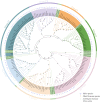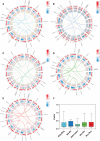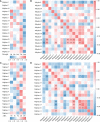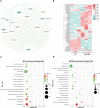Identification of PLATZ genes in Malus and expression characteristics of MdPLATZs in response to drought and ABA stresses
- PMID: 36743567
- PMCID: PMC9890193
- DOI: 10.3389/fpls.2022.1109784
Identification of PLATZ genes in Malus and expression characteristics of MdPLATZs in response to drought and ABA stresses
Abstract
Plant AT-rich sequences and zinc-binding proteins (PLATZ) play crucial roles in response to environmental stresses. Nevertheless, PLATZ gene family has not been systemically studied in Rosaceae species, such as in apple, pear, peach, or strawberry. In this study, a total of 134 PLATZ proteins were identified from nine Rosaceae genomes and were classified into seven phylogenetic groups. Subsequently, the chromosomal localization, duplication, and collinearity relationship for apple PLATZ genes were investigated, and segmental duplication is a major driving-force in the expansion of PLATZ in Malus. Expression profiles analysis showed that PLATZs had distinct expression patterns in different tissues, and multiple genes were significantly changed after drought and ABA treatments. Furthermore, the co-expression network combined with RNA-seq data showed that PLATZ might be involved in drought stress by regulating ABA signaling pathway. In summary, this study is the first in-depth and systematic identification of PLATZ gene family in Rosaceae species, especially for apple, and provided specific PLATZ gene resource for further functional research in response to abiotic stress.
Keywords: Malus; PLATZ; Rosaceae species; co-expression network; drought stress.
Copyright © 2023 Sun, Liu, Liang, Luo, Yang, Feng, Wang, Guo, Ma and Zhao.
Conflict of interest statement
The authors declare that the research was conducted in the absence of any commercial or financial relationships that could be construed as a potential conflict of interest.
Figures








Similar articles
-
Genome-wide analysis of MdPLATZ genes and their expression during axillary bud outgrowth in apple (Malus domestica Borkh.).BMC Genomics. 2023 Jun 15;24(1):329. doi: 10.1186/s12864-023-09399-x. BMC Genomics. 2023. PMID: 37322464 Free PMC article.
-
Characterization and Comparison of the CPK Gene Family in the Apple (Malus × domestica) and Other Rosaceae Species and Its Response to Alternaria alternata Infection.PLoS One. 2016 May 17;11(5):e0155590. doi: 10.1371/journal.pone.0155590. eCollection 2016. PLoS One. 2016. PMID: 27186637 Free PMC article.
-
Evolution and functional analysis of the GRAS family genes in six Rosaceae species.BMC Plant Biol. 2022 Dec 6;22(1):569. doi: 10.1186/s12870-022-03925-x. BMC Plant Biol. 2022. PMID: 36471247 Free PMC article.
-
Comprehensive Genome-Wide Analysis and Expression Pattern Profiling of PLATZ Gene Family Members in Solanum Lycopersicum L. under Multiple Abiotic Stresses.Plants (Basel). 2022 Nov 15;11(22):3112. doi: 10.3390/plants11223112. Plants (Basel). 2022. PMID: 36432841 Free PMC article.
-
PLATZ transcription factors and their emerging roles in plant responses to environmental stresses.Plant Sci. 2025 Mar;352:112400. doi: 10.1016/j.plantsci.2025.112400. Epub 2025 Jan 27. Plant Sci. 2025. PMID: 39880126 Review.
Cited by
-
Genome-Wide Identification of CaPLATZ Family Members in Pepper and Their Expression Profiles in Response to Drought Stress.Genes (Basel). 2025 May 24;16(6):632. doi: 10.3390/genes16060632. Genes (Basel). 2025. PMID: 40565524 Free PMC article.
-
Investigating the Role of OsHDT701 and Other Blast-Associated Negative Regulatory Genes in Indica Rice Cultivar Ranjit Using Combined Wet Lab and Computational Approaches.Mol Biotechnol. 2024 Oct 30. doi: 10.1007/s12033-024-01310-7. Online ahead of print. Mol Biotechnol. 2024. PMID: 39476286
-
Genome-Wide Study of Plant-Specific PLATZ Transcription Factors and Functional Analysis of OsPLATZ1 in Regulating Caryopsis Development of Rice (Oryza sativa L.).Plants (Basel). 2025 Jan 7;14(2):151. doi: 10.3390/plants14020151. Plants (Basel). 2025. PMID: 39861505 Free PMC article.
-
Exploring the Roles of the Plant AT-Rich Sequence and Zinc-Binding (PLATZ) Gene Family in Tomato (Solanum lycopersicum L.) Under Abiotic Stresses.Int J Mol Sci. 2025 Feb 16;26(4):1682. doi: 10.3390/ijms26041682. Int J Mol Sci. 2025. PMID: 40004146 Free PMC article.
-
Identification and Functional Characterization of Abiotic Stress Tolerance-Related PLATZ Transcription Factor Family in Barley (Hordeum vulgare L.).Int J Mol Sci. 2024 Sep 23;25(18):10191. doi: 10.3390/ijms251810191. Int J Mol Sci. 2024. PMID: 39337676 Free PMC article.
References
-
- Azim J., Khan M., Hassan L., Robin A. (2020). Genome-wide characterization and expression profiling of plant-specific PLATZ transcription factor family genes in Brassica rapa l. Plant Breed. Biotechnol. 8 (1), 28–45. doi: 10.9787/PBB.2020.8.1.28 - DOI
-
- Bastian M., Heymann S., Jacomy M. (2009). Gephi: an open source software for exploring and manipulating networks. Int. AAAI Conf. weblogs Soc. media 8, 361–362. doi: 10.13140/2.1.1341.1520 - DOI
-
- Bhargava S., Sawant K. (2013). Drought stress adaptation: metabolic adjustment and regulation of gene expression. Plant Breed. 132 (1), 21–32. doi: 10.1111/pbr.12004 - DOI
LinkOut - more resources
Full Text Sources

